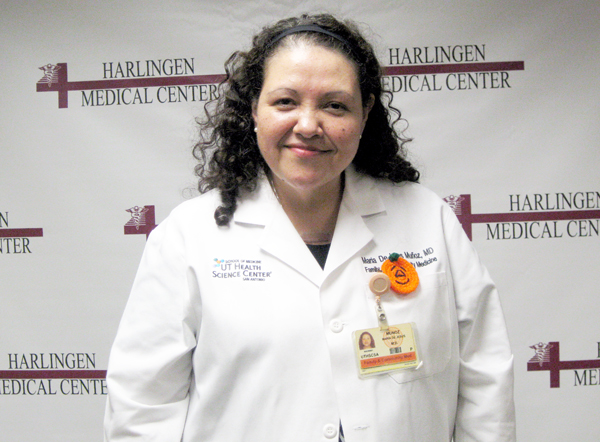- La Feria Community Holds Succesful Business Mixer Event
- Little Nashville to Take Place in Downtown Mercedes
- Lions Basketball Captures District Gold
- La Feria ISD Students Compete in Regional Chess Tournament
- Lions End First Half of 32-4A on a High Note
- La Feria ISD Held Another Successful Parent Conference
- Strong Appearance for Lions at Hidalgo Power Meet
- LFECHS Students Get to Meet Local Actress
- Students Participate in Marine Biology Camp
- Two LFECHS Students Qualify for All-State Band
Breast Cancer & You
- Updated: December 13, 2013
Noted Physician Reviews Latest Advancements in Treatment
Harlingen Family Medicine Specialist, Maria Munoz M.D. spoke to an attentive audience about the latest advances in the treatment of increasing numbers of breast cancers in women and men of all ages. The speaker is a highly respected, Board Certified, Family Practice physician. She is also an educator and published physician. The well-attended program was the first in a series of DOC TALK seminars scheduled at Harlingen Medical Center during the 2013-2014 winter season. The program coincided with National Breast Cancer Awareness Month.

Maria Munoz, M.D. stresses cancer prevention at DOC TALK lecture. Photo: Bill Keltner/LFN
The doctor began her PowerPoint lecture by talking a bit about herself. She was a Registered Nurse before she became a doctor. “As a nurse, I saw women come in with metastatic breast cancer for treatment that could have been prevented by early detection and prevention,” she said with a tinge of sadness. “I’ve seen some tragic cases with outcomes that were not necessary,” she said, adding, “that is probably why I chose this specialty–to do what I could.”
The guest speaker first defined breast cancer. It is when abnormal cells develop from normal cells in the breast to form tumors. Tumor cells have genetic defects that allow the cells to grow too rapidly and to invade normal tissues. 90% of women with breast cancer have tumors due to spontaneous new mutations.
Doctor Munoz got everyone’s attention when she said that breast cancer impacts over 240,000 new patients a year in the United States. Adding that approximately every three minutes, a woman is diagnosed with the cancer, and every 12 minutes breast cancer claims another life. More disturbing is that 70% of breast cancer cases occur in women who have no identifiable risk factors! And it is not just a woman‘s disease. “In men, she said, “1500 new cases of breast cancer are expected to be diagnosed next year. “No one really knows for certain why some women and certain men develop breast cancer and others do not.”

Doctor Munoz demonstrates proper way to perform a breast self-examination.
What is known, she said is that the patient has not done anything wrong in his or her life that caused the cancer. You can’t “catch” the cancer. It is not caused by stress or injury to the breast. There are some risk factors which you cannot change, such as: race, menstrual history, age, family member with the disease, and radiation exposure. “Race, for example,” she said: “Asian and American Indian women have a lower risk than others; No one knows why. However, it is known that getting older DOES increase your risk starting at age 40.”
Now, what to do: “Prevention is the Key,” she said, continuing on to explain the 3 most important things a woman can do. Firstly, she listed getting regular mammograms. This
should be done annually for women over 40 and stopping at 75 years-old, according to the American Cancer Society. The X-ray technician is looking for changes in the skin and breast tissue so as to compare it with your previous mammograms. She digressed to say that the latest digital X-ray mammograms expose the patient to very little X-radiation.
“And,” she added, “if the X-ray machine is hurting you, tell the technician so he can adjust it for more comfort.”
Secondly, have a regular Clinical Breast Examination (CBE) by a qualified healthcare provider right after your period when breasts are not tender or swollen. And, thirdly, Self-awareness, meaning a monthly thorough self breast examination (BSE). The doctor then showed slides and gave an in-depth demonstration on a realistic dummy on how to properly do a Self Examination.
These steps can alert the patient and her doctor to the 5 warning signs and symptoms of breast cancer, and can be life-saving: (1) A painless lump or thickening, (2) A thickening or swelling that persists, (3) Nipple pain or retraction, (4) Breast skin irritation or dimpling. (5) Spontaneous nipple discharge. Comfortingly, Doctor Munoz told the ladies in the audience that 9 out of 10 breast lumps found are not cancerous.
However, if cancer is found, there are effective treatments for the disease. Munoz explained that the doctor and his patient have the options of: (1) Surgery, (2) Chemotherapy, (3) Radiation Therapy, (4) Hormone Therapy, and (5) Immunotherapy.
The doctor commented on some progress being made in treatments, mentioning that a NSABP-P1 trial has shown that women with an increased risk for breast cancer can have that risk decreased by 40-50% by taking the anti-estrogen medication Tamoxifen.
Doctor Maria Munoz, M.D. is available to answer your questions on breast cancer prevention at Medland Associates in Harlingen. Her number is (956) 230.2933

Harlingen Medical Center.


